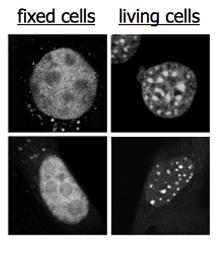A Temporal Threshold for Formaldehyde Crosslinking and Fixation
Bird lab paper featured in PLoS ONE.

Authors
Lars Schmiedeberg., Pete Skene., Aime´ e Deaton, Adrian Bird
PLoS ONE. 2009;4(2):e4636. Epub 2009 Feb 27.
Summary
In cells that are fixed with formaldehyde the nuclear protein MeCP2 localises to dots that coincide with condensed regions of the chromosomes. Mutants of this protein (R111G, T158M, R168X) which cause the autism spectrum disorder Rett Syndrome often fail to localize properly in fixed cells and appear spread throughout the nucleus. When MeCP2 is viewed by microscopy of living cells however, all mutant forms are seen to localize to nuclear dots and there is no difference between them and normal protein. Our results show that formaldehyde fixation is unable to capture the true distribution of MeCP2 as seen in living cells. We explain this discrepancy by showing that brief protein-chromosome interactions escape fixation. These findings establish a lower time limit that is necessary for protein interactions to be fixed by chemical cross-linking.

